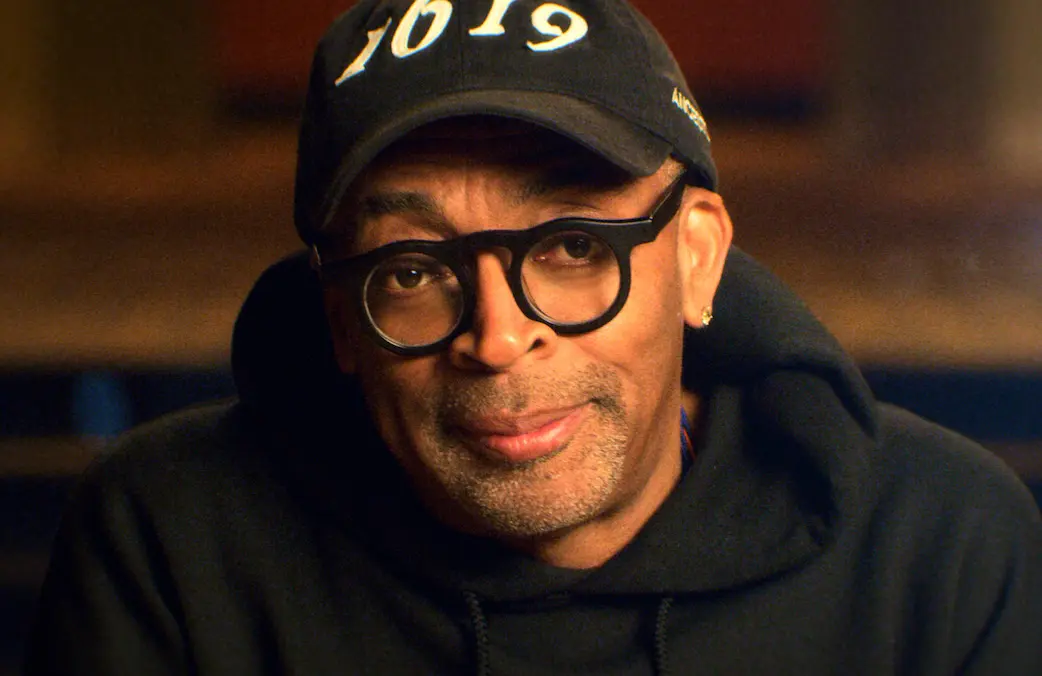Apple TV+'s Dear... Looks at Famous People Through the Eyes of Their Fans
-
 Spike Lee in Dear.... (Apple TV+)
Spike Lee in Dear.... (Apple TV+)Attention all readers: If you or your viewing partner adores — and I mean absolutely adores — any of the following people, please report to the second paragraph: Spike Lee, Oprah Winfrey, Jane Goodall, Yara Shahidi, Stevie Wonder, Misty Copeland, Gloria Steinem, Lin-Manuel Miranda, Aly Raisman, and Big Bird. The rest of you may read on, but don’t say you weren’t warned.
So AppleTV+ has a new show called Dear…, which I’m pronouncing “dear dot-dot-dot,” in which very famous and beloved figures try to look humble while reviewing their life accomplishments and receiving gushing tributes from their admirers.
Now, if you’re of a certain age this concept will sound mighty familiar. That’s because Dear… is a callback to one of the warhorses of television’s golden age — This Is Your Life, a show created and hosted by Ralph Edwards in the 1950s and then in various revivals after that. Every week a celebrity guest agreed to let Ralph walk them through their careers with help from a few “surprise” walk-on guests. Time magazine called it “the most sickeningly sentimental show on the air,” but viewers couldn’t get enough of it. Judge for yourself (and, at about the 8:40 mark, watch Jack Paar battle with Edwards for control of the show):
Director R.J. Cutler, a documentary giant who can do serious and fluff with equal élan, has figured out a stylish way to keep all the celebrity worship from sloshing over the top. First, there is no Ralph Edwards. The celebrity tells the stories behind their greatest hits.
Cutler’s staff has fans of the celebrity fans read a letter that they’ve written to that person, telling the celeb how she or he changed their life. The reading is not done in a studio, but in the world of the fan.
For instance, in the series’ opener, director Spike Lee is feted by M. Christopher Brown II, the president of Kentucky State University, a historically black university. In a visual trope that is used throughout the series, Dr. Brown reads his letter while walking or sitting in various real-life scenes from his life. When he describes watching Lee’s second film, School Daze, he’s in a movie theater. When Brown reads the part about being inspired to attend a historically black university, he does it while walking the campus of Kentucky State.
Likewise, former WNBA star Candice Wiggins is shown in her athletic element while reading her letter to Lee, explaining how his film He Got Game helped her understand what it was like for her father, baseball player Alan Wiggins, to struggle with drug addiction while playing professional sports.
The Spike Lee episode is worth watching because of these and other impressive testimonials from African-American leaders who credit Lee’s art with changing their life trajectories. Also, it’s timely and fascinating to watch 30-year-old footage of Do the Right Thing and hear Lee talk about it today: “Gentrification, police brutality — the film is still relevant,” he says.
The second episode, featuring Hamilton creator Lin-Manuel Miranda, is similarly topical and powerful — but it’s because Cutler is working with such great material. It might be the best 20-minute Lin-Manuel Miranda documentary ever made. And he’s a great interview. “As an artist, I know I cannot control the success or failure of a thing I make,” Miranda says. “Every time you make something, you’re throwing rocks into a pond. You never know what ripples will come back to you.”
Unfortunately, it’s when those ripples come back, in the form of fan letters, that the episode starts to sag. A couple of those letters are genuinely inspiring — in one, a teen growing up in the South credits Miranda with his decision to come out. But overall the letters pale next to the story of Hamilton and how it came to be.
Other episodes of Dear… are less endearing. It’s nice to hear that Stevie Wonder inspired a college counselor when she was losing her eyesight, but the testimonial loses its oomph when we learn the counselor got a lot of her vision back. We see her reading her letter while walking down the street.
And maybe it’s just my age, but I don’t think black-ish star and self-described “budding humanitarian” Yara Shahidi is old enough to warrant a retrospective complete with fangirl mail. Also, I don’t think people should ever refer to themselves as “humanitarians,” any more than they should refer to themselves as devoutly religious or practically perfect.
Of the first 10 celebrities featured on Dear… I’m guessing the one who’s gotten the most fan mail over the years is Big Bird. But honestly, if you want to be inspired by this eight-foot child whisperer, you can do better than hearing people gush about him for 23 minutes. Watch the story about his creator — and for nearly 50 years, the man who wore the costume — Caroll Spinney, the subject of the 2015 documentary I Am Big Bird, now streaming for free on Kanopy and other sites.
This show feels very on-brand for Apple in that it emulates the glossy production values and reverence for the brilliant and famous that have been hallmarks of Apple’s advertising campaigns over the years. I’m not really into half-hour commercials, but if you really, really like the people profiled in Dear… it likely won't feel like a commercial to you.
All ten episodes of Dear... drop today on Apple TV+.
Aaron Barnhart has written about television since 1994, including 15 years as TV critic for the Kansas City Star.
TOPICS: Dear..., Apple TV+, This Is Your Life, Aly Raisman, Gloria Steinem, Jane Goodall, Lin-Manuel Miranda, Misty Copeland, Oprah Winfrey, R.J. Cutler, Spike Lee, Stevie Wonder, Yara Shahidi, Documentaries